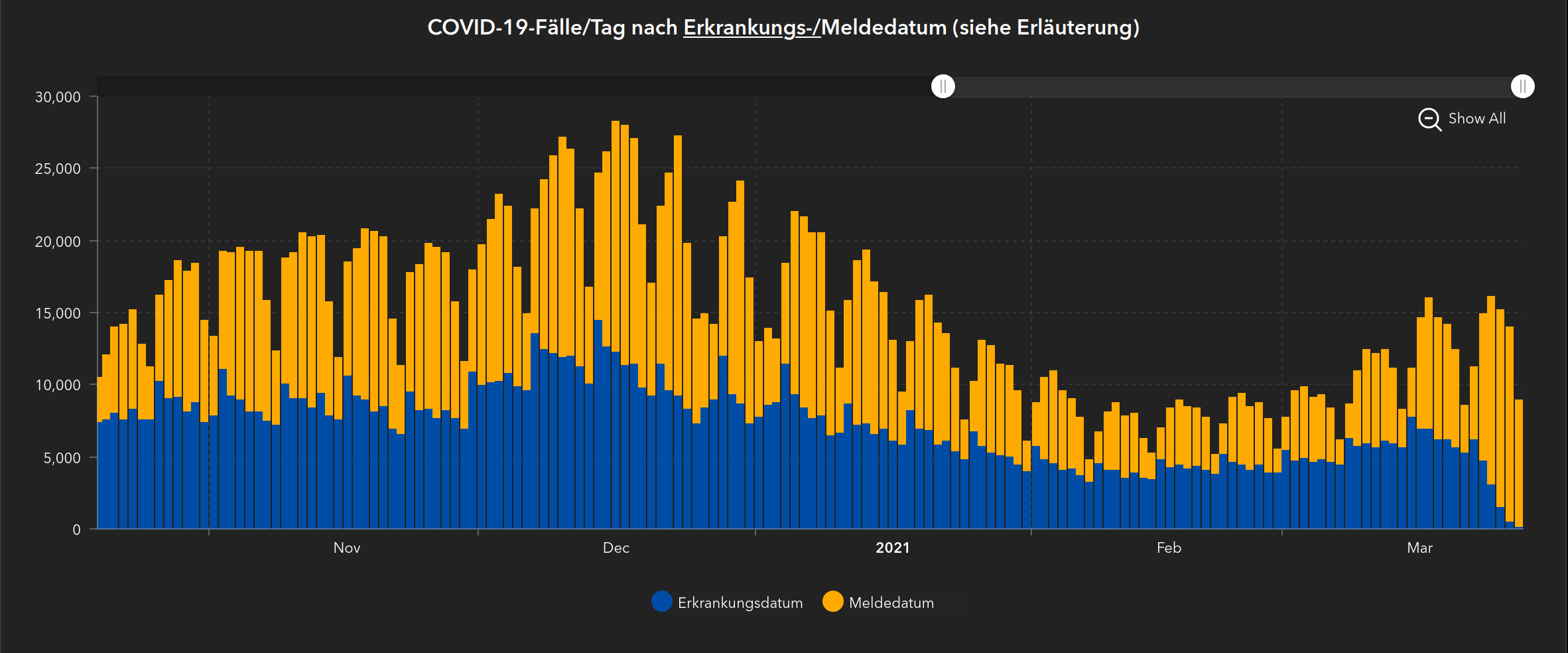The week in German COVID-19 politics
This week’s inconsistent pandemic management and communications chaos makes priorities of Merkel government painfully obvious. Interests of commerce and employers take precedence over pandemic control.

The third wave of the Corona pandemic is on the rise in Germany. Blue: date of symptom onset. Yellow: date of reporting. Y axis: number of cases. Source: RKI.
On Monday March 22, Angela Merkel met the prime ministers of all German states for another round of discussions on the coronavirus pandemic. The meeting went on deep into the night, and the next morning, Merkel presented a plan to introduce the hardest lockdown Germany has seen since the beginning of the epidemic, that was supposed to have taken place during the Easter holidays from April 1-5. The the five day suspension of all public, private and commercial activities would have acted as a “circuit braker” to halt the current rise in new coronavirus infections in Germany, caused for the most part by the new English variant B.1.1.7.
The lockdown would have been much needed indeed. Three weeks ago, the federal government and the conference of the prime ministers of German states introduced an easing of the nation-wide lockdown in a situation where a rise in incidence by the more infectious mutant SARS-CoV-2 variant was already clearly predicted. This action was not requested or supported by a majority of the population, and it still isn’t. Rather, it is something that employers and commerce are lobbying for.
Unfortunately, the plan for the mini-lockdown didn’t stick. After announcing the hard lockdown, it became appearant, the many details around the extra holidays were not easy to regulate on such short notice (ie. paychecks of employees, compensation for lost profit, etc). Thus, according to Merkel, benefit and costs would have been disproportionate. Also, medical experts have expressed doubts about the efficacy of such a short lockdown. To her credit, Merkel took responsibility saying “The error is mine and mine alone”. But whatever the arguments, the fact of the matter is that the Merkel government is not flexible enough or rather, strong enough to organize a nation-wide lockdown for a few days on 10 days notice. Merkel’s famous policy of compromise is failing - interests of the economy seem to trump human lives. With incidence as high as on December 18 2020, death toll is expected to peak again in several weeks (death tolls lag behind infections by 3-4 weeks).
So what remains of the decisions of the last government crisis meeting? Nothing. Germany will continue its current version of “lockdown light”. There is no federal decision about operation of schools and daycare after Easter (this is traditionally in the competence of states). It is business as usual in many factories and offices, as there is still no mandatory home-office ruling, hygiene or testing concepts for employers. There is also no mandatory testing in schools and day-care. Vaccinations are lagging, because of enormous organizational issues and shattered trust in the AstraZeneca vaccine, for both of which the CDU-led Ministry of Health and federal minister Jens Spahn must assume responsibility. Spahn, however, is far from expressing the level of statesmanship demonstrated by his chancellor. Rather than admitting mismanagement in the face of rising incidence and vaccine-chaos, he said the following on March 19 “This week has once again shown us, how unpredictable this pandemic is.”
Really? Experts have already warned at the end of February of an exhaustion of ICU beds, because of the more infectious variant B.1.1.7 and if lockdown measures are not increased. Instead, they were decreased on March 4 and the “emergency break” (“Notbremse”) for strengthening lockdown measures was set at a 7-day-incidence of 100 instead of 35, the limit that was previously publicly discussed for most of February. Now, the incidence is well over 100 in most federal states, but previously announced provisions have not come into effect.
Come on, Germany.